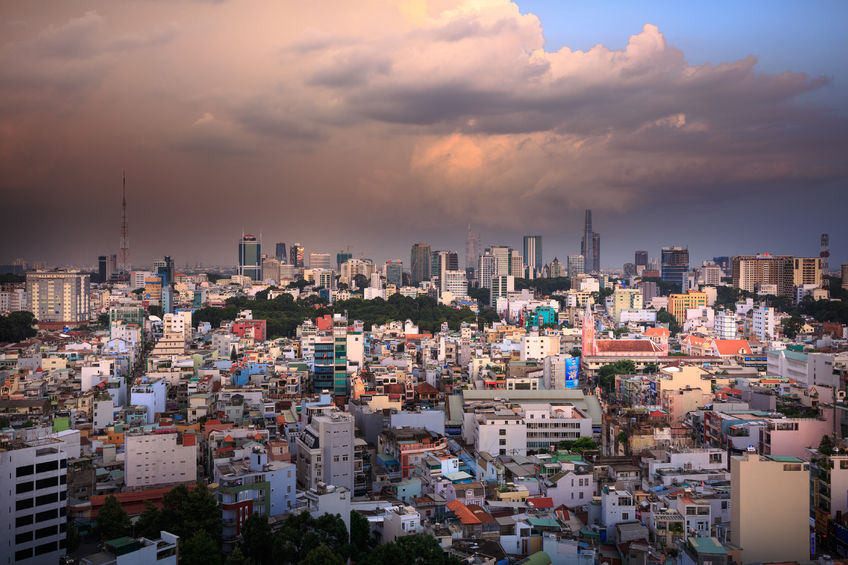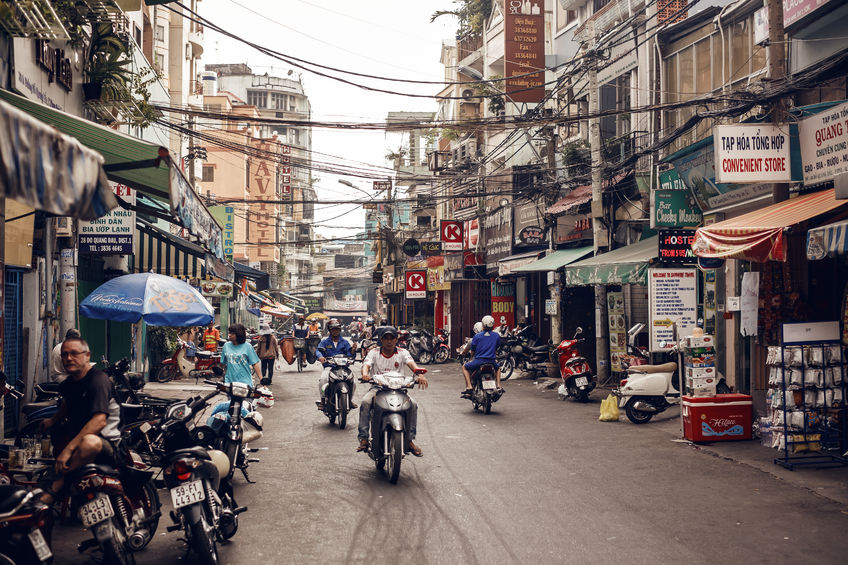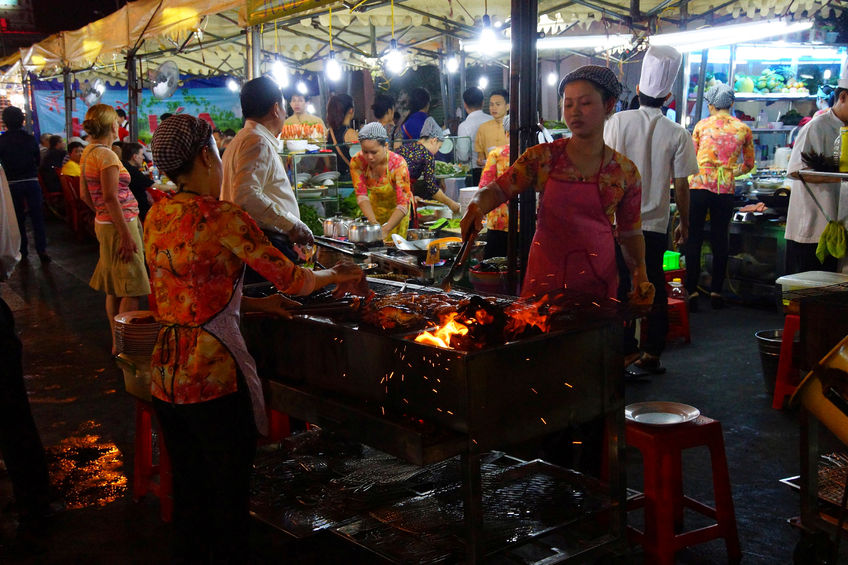

From the east coast of the United States, it takes about thirty hours of travel to reach Vietnam. My first trip outside the country—my first flight—was an odyssey: I flew from Greenville, South Carolina to Dulles (Washington D.C.), then to Narita (Japan), then on to Tân Sơn Nhất in Ho Chi Minh City, whose residents still call it “Saigon.” This was all new territory for me. Even in the U.S., I had never travelled significantly. Washington, D.C. was the largest city I had visited. Nothing had prepared me for Saigon. The first drive through the city was almost surreal. At 12 a.m., the streets were empty, and the buildings hulked over us.
When we got to my family's house, my wife's aunt insisted on going out to eat phở. We walked out to the street to a stand that she knew, and sat eating soup on the sidewalk at midnight. The city was mostly dark. Lights are more utilitarian there, not wasted in houses where people are sleeping or on closed businesses. A few LED signs flashed, advertising an ATM or a hotel. As we ate, some of them winked out as the proprietors closed up shop.

Manhattan is the densest place in the United States. It has a density of around 26,000 people per square kilometer. The urban core of Saigon has about 40,000 per km2. In the outer, “suburban’ districts, the density falls to only about 20,000 per km2—more dense than Brooklyn. It is a dense place. Its density is a sensory assault. Everywhere you look, there are advertisements, brightly colored buildings, businesses, and thousands of motorbikes. There are smells: the smells of cooking, industry, diesel, inadequate sewer infrastructure. Noise is constant. Even at night, buses and trucks rumble by. Using a sound meter on my phone, I measured the daytime noise at street level at around 80 decibels.
This is not a comfortable level of density for me. If the U.S. built a city as dense, the entire population could live in a space slightly larger than Delaware. Culturally, though, it seems to work: the Vietnamese live more communally than Americans, and the density is made up of families living beside families. In my family's house, for example, there are five bedrooms, and usually at least fifteen people living in the house at any given time (most Vietnamese children co-sleep with their parents, as is common in Asia). This can come as a shock for American visitors—most of us grow up and live in nuclear families, and those who don't have usually grown up with only one parent instead. The idea of aunts, uncles, and cousins living with us, not to mention in-laws, is either amazing or horrifying, depending on our family situation.

Houses in Vietnam are built tall and narrow. Historically, families owned strips of land. The village road ran through the center of town, and families used their strip of land as a place to build a house and to farm rice. Taxes were charged based on how wide their houses were. As such, most homeowners in Vietnam buy a five meter strip of land and build a house on it, with the bottom floor dedicated to a commercial space. This is called a mặt tiền, which literally means “money face.” Mixed use is the holy grail for planners in the U.S., but Vietnamese homeowners have arrived at the same idea via a vernacular architecture that emphasizes that land should produce value for its owners. The downstairs shop is generally dedicated to a family business, or may be rented to another local shopkeeper or even an international corporation. (There's something surreal about seeing a Pizza Hut located in the bottom floor of someone's house.)
The effect on the local economy is notable. In the suburban area where I live in the U.S., I have a choice of a dozen or so non-fast-food restaurants within ten minutes' drive; there may be three or four coffee shops (if we count Starbucks). In the area around my family's house in Vietnam, there are probably twenty or thirty restaurants and at least a half-dozen cafes within ten minutes' walk. Almost all of these businesses are specialists. When there is so much competition, you can't afford not to be: you serve your best dish, and people come to your restaurant to eat it. If you are particularly popular, you will attract satellite businesses. Near the cơm tấm (broken rice) restaurant across the street, for example, there are people who sell desserts (chè ba màu) and sugar cane juice (nước mía). If you order one to go with your breakfast, the proprietor will take your money, run out to the stand and buy you one. It's an interesting (and surprisingly effective) ecosystem: by being good at what you do, you attract others who can profit from proximity to you, and in turn make your restaurant more attractive by offering additional options.

Most Americans work for corporations, eat at corporate restaurants, shop at corporate stores. “Buy Local!” often seems like the mantra of people who don't have a grasp on reality: how can you afford to buy local when it costs three times as much as Target? Saigon illustrates what happens when everyone buys local. I might go to a coffee shop and buy enough drinks for everyone who is in the family shop that morning. The proprietor then spends the profit to buy lunch at a local shop. The proprietor there brings her profit for the day to my family's jewelry store and exchanges the money for gold. The next day, I use some of the family's money to buy drinks at the local coffee shop... and so on. The result of this cycle is that the money's effect is multiplied: it may be spent five times within a day or two, in the space of a few acres. Each dollar has power. Compare the American model, in which an impoverished person receives money from the government, then spends that money at Wal-Mart: the money came from outside the community, immediately left the community, and the only benefit is that the local person had food to eat and the cashier who checked her out made a few cents.
Entrepreneurship is a cultural necessity. Working for someone else, while not exactly shameful, carries less status than working for yourself—even if your work is “low status.” There is a church near my family's home. Around this church there is a large gathering of food carts. The gathering is permanent, although the membership shifts. My wife remembers one cart in particular, which sells bò bía, from her childhood two decades ago. A husband and wife team have been running that cart together, and supporting their family, for thirty years.
There are supermarkets. They are similar to a scaled-down version of Target or Wal-Mart, and are called co.opmart and LOTTEMart. They're pleasant, air-conditioned, inexpensive... and mostly empty. Locals prefer to shop at the wet market, where farmers come every day from the countryside to sell their wares. This can be an eye-opening experience. Local markets are inaccessible to most tourists (the tourist markets are more sanitized, expensive, and oriented toward dry goods), can be difficult to find even once you realize they exist, and are dirty beyond belief. I don't mean this metaphorically, or in the sense that they are merely unsanitary: they really are dirty, as they are held in dirt lots, people wash their spaces with water, drive motorbikes through the muck, and so on. It is a truly foreign experience (...and really drives home the importance of washing your food). Of course, it's also worth noting that you can buy a kilogram of leafy greens for 20,000₫ (about $1), which is less than a quarter of the equivalent in the U.S., where turnip greens average about $4.40 per kilogram.

Food is cheap, local entrepreneurship is easy, and people prefer to start businesses rather than work for “the man.” What's not to love? Oddly enough, planning and regulation have their upsides. You're more likely to get food poisoning eating the (delicious) street food in Vietnam. Water isn't nearly as safe to drink. You probably prefer that your neighbors not build their house five stories high. It's an even safer bet that you don't want them to run a chemical emporium or auto repair shop out of the first floor. You may even prefer that they not park motorbikes on your front porch. All of this, and more, commonly happens in Vietnamese cities, and people generally have no recourse other than interpersonal diplomacy.
It's strange to say, but Vietnam—nominally a centrally planned, command economy—probably gives a more honest view of unregulated small-scale capitalism than anywhere in the United States. Even in famously unzoned Houston, the car-dependent development patterns we favor allow large developers and corporations to dominate the landscape. You don't often see a street full of people who have decided to make their mặt tiền into a series of small-scale machine shops in the United States; nor will you see something like Saigon's art district (a street where there are literally dozens of artists' studios), or the wedding dress district, or the electronics market where you can buy practically any consumer electronic item made in the last forty years. The unzoned, unregulated businesses seem almost like the Internet of the 1990s: throw up a server (or a roadside stand) and sell widgets. The world is your oyster!—even if the neighbors hate you.

The energy of a city is in its creative disorder. Saigon has many challenges: infrastructure, inequality, governance, and transportation. Walk or drive around the city, though, and it becomes clear that it has a vitality that many Western cities lack. Especially at night, the city bursts with life: noise, light, humanity. What allows that creative energy?
Density. As noted above, Saigon is more dense than any place in the United States. Any business has a built-in clientele simply based on the number of people who live around it; this allows businesses that would otherwise be marginal in the U.S. to thrive. This doesn't mean that the U.S. needs to build places as dense as Saigon. It is likely too dense for health and comfort. Nevertheless, it's worth noting that we could increase the density of many of our mid-sized cities tenfold before we approached the density of Saigon.
Space. The streets are shared spaces. Pedestrians cross unpredictably. Vehicle traffic is mixed, with people pushing hand-carts beside buses and trucks. The speed of travel is slow, out of necessity. Families unfold tables and have dinner on the sidewalk. They might take a plate over to the night guard of the bank next door. A business that is closed for the day becomes the site of a late-night food stand. Streets that are dedicated to government or institutional uses may be turned into all-night markets during festivals like Tết.
Size. Any development in a United States city is likely to be undertaken by a developer. Apartment buildings, retail buildings, even single family homes are built by a commercial entity. In Vietnam, however, most homes are small and built by families. Most homes include commercial components. This is fertile ground for Jane Jacobs' argument that cities need older buildings. A brand new, high rent building might be leased to a bank; the building directly next door might be ramshackle and old, and used for a restaurant run by the owners. This is a recipe for resilience. Many of these buildings and their businesses have surived the French colonial period, the Vietnam War, the reunification, and widespread modernization.
Investment. Vietnam is a poor country. Its GDP per capita is around $2000 per year. Its currency is weak. Tax collection is “unreliable.” Government services are nonexistent. Only the major highways and thoroughfares are reliably maintained. Still, the cities function. Small businesses thrive. The city remains a human place, growing and changing, despite a lack of big-box development and government infrastructure. The city is a place of sensible investment by millions of people, rather than an artifact of wishful thinking: “If we pave Route 38, Wal-Mart will build a SuperCenter here, and our town will be fine.”